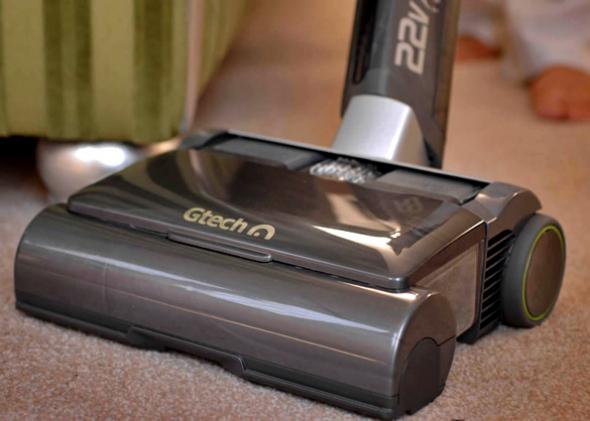This week, Slate is reviewing all the “smart” gizmos we can get our hands on. Read all the entries here.
For a guy who has spent his whole career building vacuum cleaners, Nick Grey doesn’t hold a high opinion of most vacuum cleaners.
“The first vacuum cleaner, they just made a wooden box, they stuck a motor at one end and a bag at the other, and then they had a tube,” he says. “And the industry has just done variants of that for a hundred years.”
Ten years ago, Grey left his post as head of product development at an established British manufacturer to rethink the vacuum from the floor up. This year, his Worcestershire, U.K.–based company came out with a product that he believes represents a leap forward. It’s called the Gtech AirRam, and it’s as delightfully techie as it sounds.
Gtech began by jettisoning the most vexing component of your standard upright vacuum: the cord. Handheld dust-busters can get by with batteries, because they’re not very powerful. But full-size vacuums tend to need cords because it takes a lot of wattage to suck dirt through a brush, around a fan, and all the way up a tube into a dust bag. The AirRam dispenses with the tube and puts the dust compartment right in the head of the vacuum. Now the dirt only has to travel 1½ inches.
The power comes from a lithium-ion battery, as in many other high-end consumer electronic gadgets—and electric cars, for that matter. Between its potent battery and relatively low energy demand, it can run for 40 minutes on a single charge, enough to clean a good-sized house.
Other features are similarly well-conceived. The brush is more minimal than your typical vacuum brush, requiring less maintenance. The dust is compacted into tidy little blocks that are easy to remove. And the lack of a hose and bag make the handle surprisingly light and agile. It twists and pivots with a wide range of motion, making it easy to slide under tables or into corners. The whole thing weighs just 7.7 pounds, making it a godsend for the older and frailer among us.
A final, geeky flourish is a USB port and software that allow you to hook up the AirRam to your computer and analyze your battery life, energy savings, and even calculate how many calories you burned while vacuuming. Grey says he added that feature as something of a joke, but “people loved it,” so it stayed in the final product.
As smart devices go, the AirRam’s analytics are on the gimmicky side. If intelligence is what you’re after, the Roomba is in a different class. But Grey insists the Roomba can’t match the AirRam’s cleaning power.
To prove it, the company lent me an AirRam to try out on my home carpets and floors. When I first turned it on, the sound was a little disconcerting. It’s much thinner than the throaty whine of even my relatively lightweight Eureka upright vacuum. I was actually worried something might be wrong with it.
But sounds can be deceiving. The AirRam made light work of my off-white living-room rug, which usually requires multiple passes before it starts to resemble its original shade. It handled my other rugs and hardwood floors with equal aplomb. It worked so well, and was so easy to maneuver, that I began to look around for other surfaces to clean.
My eyes alighted on the five-level, 48-inch cat tree in the corner of the room, which is so matted with cat hair that you’d have a hard time guessing that it was once pure white. I’d never think to attempt it with another upright vacuum, but the AirRam was light and maneuverable enough that, on a whim, I gave it a shot. Amazingly, it worked, taking about two years off the cat tree’s appearance. The cat trotted over to examine my handiwork, and I’m probably anthropomorphizing here, but he seemed duly impressed.
I will not be purchasing a Gtech AirRam anytime soon, for one reason: It costs $299. (I bought my trusty little Eureka for $30, used.) It’s not that the price is unreasonable, given how well it works. It’s just a lot of money to pay for a vacuum.
It also comes with far fewer bells and whistles than similarly conventional vacuums. But Grey says that was intentional. “We aimed this thing to be a bit like an iPad compared to a PC,” he told me. “It’s only got the basic things. It’s small, it’s lightweight, you can pick it up, and it cleans floors really well. It won’t dust the lampshades, and it won’t clean your car. If a feature doesn’t genuinely make the task easier, we don’t put it on.”
Actually, I think that if it can clean my cat tree, it would probably do just fine on a car. But Grey’s point is well-taken, and his Steve Jobs–like approach to vacuum aesthetics has clearly paid off. It’s enough to make you wonder what other common household technologies could use a good rethinking by someone with a keen mind for design.
